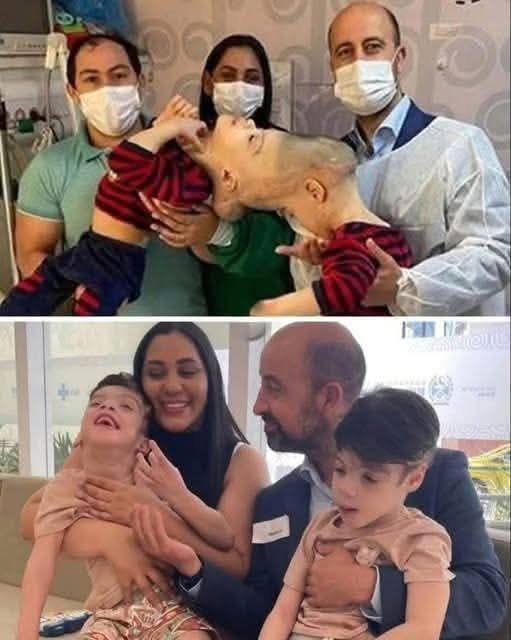Deep in the state of Roraima, Brazil—a region far from medical centers of fame—two boys were born in 2018 in a most extraordinary way: as craniopagus twins, joined at the skull. From the very first breath they shared, Arthur and Bernardo lived in a world of closeness no one else could truly imagine. Their bones, their brains—they were connected, intertwined, inseparable.
For nearly four years, they grew side by side—but never facing one another. Their lives unfolded in a single twin-fused existence, each movement tied to the other’s. For them, the concept of “looking another in the eyes” was pure fantasy.
A Rare Condition, a Daunting Challenge
Craniopagus—twins fused at the skull—is one of the rarest forms of conjoined twins. It’s estimated to occur in fewer than 1 in 2.5 million births. Their shared anatomy is often extremely complex: skull bones, blood vessels, brain tissue—all potentially intertwined in ways that defy easy separation.
In Arthur and Bernardo’s case, their skulls and parts of their brain tissue were shared. That meant that separation wouldn’t just be about cutting bone; the surgical team would have to navigate delicate blood vessels, minimize neurological risk, and preserve as much brain function as possible in both.
For years, their caretakers and doctors watched and planned. Each day was a balancing act between giving them life, hope, and safety.

The Making of a Historic Operation
The path to independence was not one sudden leap, but a long, layered journey. Over months, a team of more than 100 specialists—neurosurgeons, craniofacial surgeons, anesthesiologists, radiologists, nurses, rehabilitation experts—pooled their efforts. But they didn’t just rely on textbooks; they used virtual reality simulations to reconstruct the twins’ shared physiology in three-dimensional detail. With VR, surgeons rehearsed every cut, every move, every possible complication, step by step.
Under these virtual rehearsals, they could see where vessels tangled, where bone structures overlapped, and how brain tissue intermingled. They planned staged surgeries—multiple operations gradually easing the two apart, ensuring that neither boy lost vital function along the way.
Finally, after nine preparatory surgeries, the big day came. Surgeons embarked on the final separation—a marathon operation lasting 23 hours. For nearly a full day and night, they worked in concert, cutting, reconstructing, repairing. It was more than a technical feat—it was a delicate dance of life.
A Moment That Changed Everything
When the boys finally awakened from anesthesia, something miraculous happened: they turned their heads. Faces that had only ever been side by side, bodies that had only known shared contours—suddenly, Arthur and Bernardo gazed at one another. This was their first real eye contact ever. The first time in their entire lives that each could see the face of his twin.
That moment was more than symbolic. It was a validation of every careful decision, every agonizing risk, every sleepless hour the medical team and families endured.
For Arthur and Bernardo, the future is still full of challenges—rehabilitation, recovery, ensuring full neurological health—but they now enter it as two individuals, capable of movement, sight, and identity in ways they never had before.
What It Means for Medicine, Hope, and Humanity
This surgery is not just a local success story. It underscores how human determination, technological innovation, and collaboration can push the boundaries of what’s possible. For families in remote regions, for children born with unimaginable challenges, it reminds us that medical breakthroughs are not reserved for the privileged or the well connected. When a hundred hearts and minds unite behind one mission, they can attempt the impossible.
And as Arthur and Bernardo grow, they will carry with them a unique bond—not of necessity, but of chosen closeness. Their journey is not just about separation, but about discovery: of who they each are, now free to look outward, unbound from one another, yet forever linked in memory and origin.